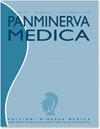分化不良的甲状腺癌:分子、临床病理特征和治疗前景。
IF 4.3
4区 医学
0 MEDICINE, GENERAL & INTERNAL
引用次数: 0
摘要
分化不良甲状腺癌(PDTC)是一种罕见的侵袭性极强的肿瘤,约占所有甲状腺癌的2-15%。与分化良好的甲状腺癌和无弹性甲状腺癌相比,分化不良的甲状腺癌具有独特的生物学行为,近年来,从解剖病理学和临床角度来看,它已被归类为一个独立的实体。然而,临床医生对PDTC的纳入标准和定义仍缺乏共识,这影响了其诊断和临床治疗。与其他肿瘤相比,PDTC更为罕见,分类也更为困难,因此迄今为止的研究非常少,而且除了PDTC之外,系列研究往往还包括不同的组织类型。本综述侧重于有关 PDTC 的主要研究,总结其诊断标准定义、临床病理特征、管理和预后方面的演变。现有数据证实,PDTC 的病理评估和分类至关重要,因此应予以标准化。由于 PDTC 的临床表现和预后可能因诊断时疾病的不同阶段而有很大差异,因此患者的治疗方法也可能不同,应根据每位患者的具体情况进行调整。最后,本综述讨论了PDTC分子研究的进展,这些进展以及体外和体内模型的实施将为了解这种侵袭性甲状腺癌的进展、转移和侵袭的生物学机制提供宝贵的信息。为了更好地评估PDTC的特殊特征,并通过重点关注最佳诊断和治疗方法来更好地确定其治疗方法,还需要对更大规模、经过仔细筛选的病例进行进一步研究。本文章由计算机程序翻译,如有差异,请以英文原文为准。
Poorly differentiated thyroid carcinoma: molecular, clinico-pathological hallmarks and therapeutic perspectives.
Poorly differentiated thyroid carcinoma (PDTC) is a rare and extremely aggressive tumor, accounting for about 2-15% of all thyroid cancer. PDTC has a distinct biological behavior compared to well-differentiated and anaplastic thyroid carcinoma and, in last years, it has been classified as a separate entity from both anatomopathological and clinical points of view. Nevertheless, there is still a lack of consensus among clinicians regarding inclusion criteria and definition of PDTC that affects its diagnosis and clinical management. Due to its rarity and difficulty in classification compared to other tumors, very few studies are available to date and series often include different histotypes in addition to PDTC. This review focuses on main studies concerning PDTC summarizing the evolution in the definition of its diagnosis criteria, clinicopathological features, management, and outcome. The data available confirm that the pathological evaluation and classification of PDTC are crucial and should therefore be standardized. Since the clinical presentation and prognosis of PDTC may vary widely depending on the different stage of the disease at diagnosis, the patient's management may differ in treatment and should be tailored to each patient. Finally, this review discusses advances in molecular insights of PDTC that, together with the implementation of both in vitro and in vivo models, will provide valuable insights into biological mechanisms of progression, metastasis, and invasion of this aggressive thyroid carcinoma. Further studies on larger, carefully selected series are needed to better assess the peculiar features of PDTC and to better define its management by focusing on the best diagnostic and therapeutic approaches.
求助全文
通过发布文献求助,成功后即可免费获取论文全文。
去求助
来源期刊

Panminerva medica
医学-医学:内科
CiteScore
5.00
自引率
2.30%
发文量
199
审稿时长
>12 weeks
期刊介绍:
Panminerva Medica publishes scientific papers on internal medicine. Manuscripts may be submitted in the form of editorials, original articles, review articles, case reports, special articles, letters to the Editor and guidelines. The journal aims to provide its readers with papers of the highest quality and impact through a process of careful peer review and editorial work. Duties and responsibilities of all the subjects involved in the editorial process are summarized at Publication ethics. Manuscripts are expected to comply with the instructions to authors which conform to the Uniform Requirements for Manuscripts Submitted to Biomedical Editors by the International Committee of Medical Journal Editors (ICMJE).
 求助内容:
求助内容: 应助结果提醒方式:
应助结果提醒方式:


